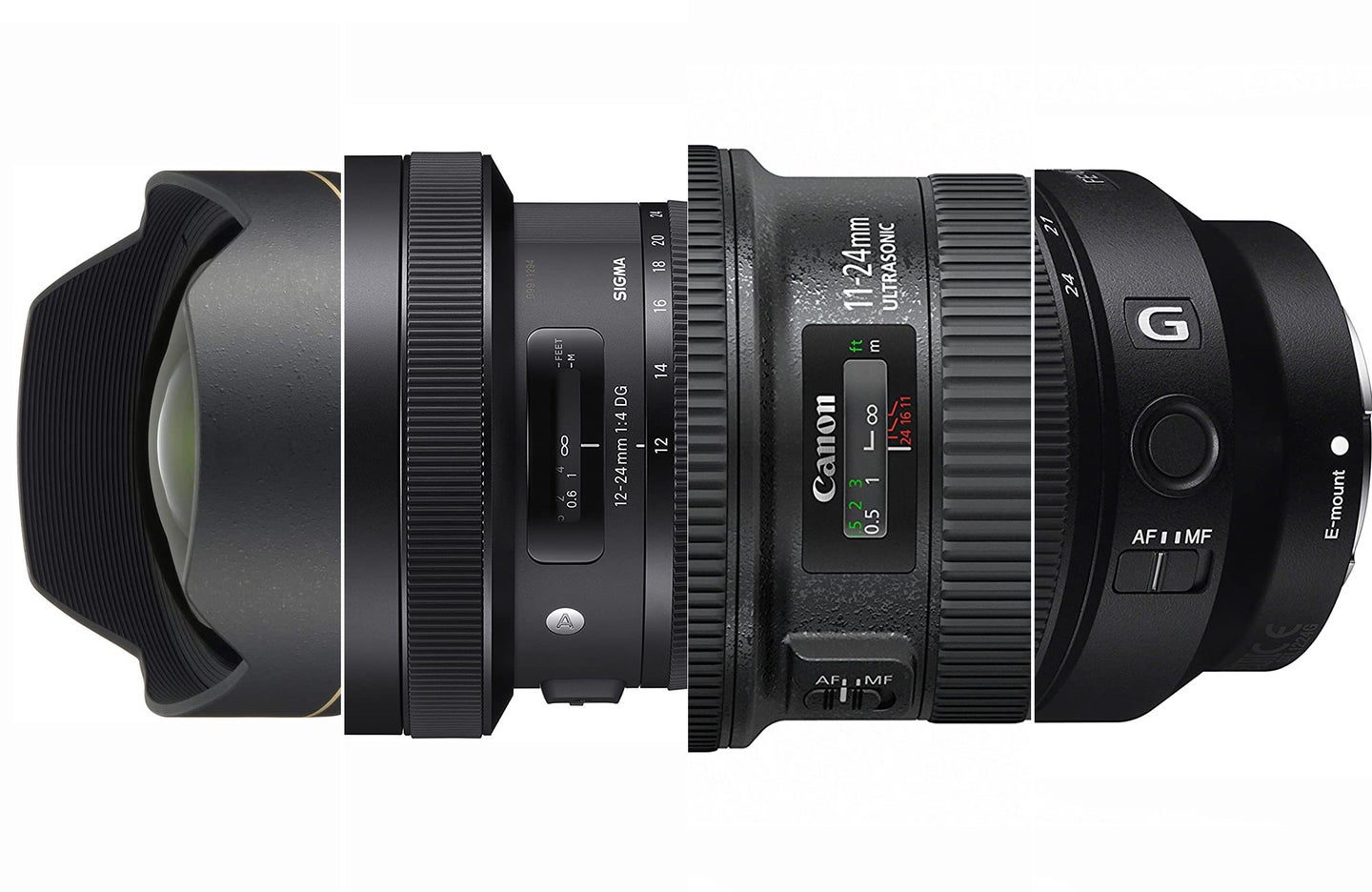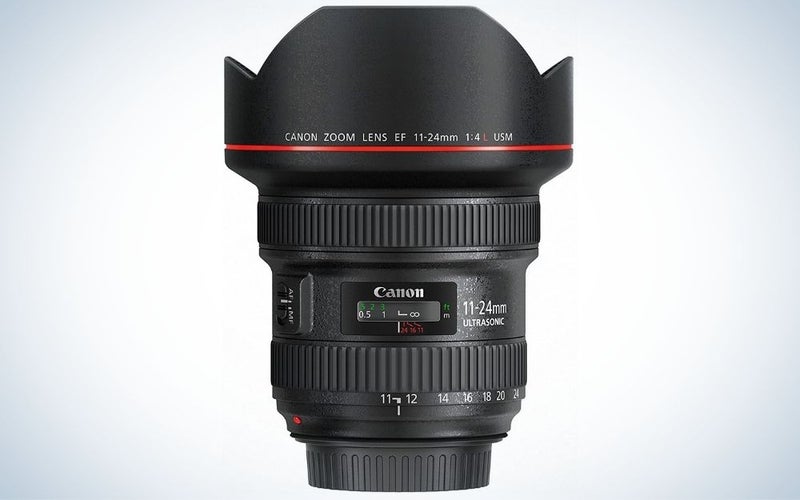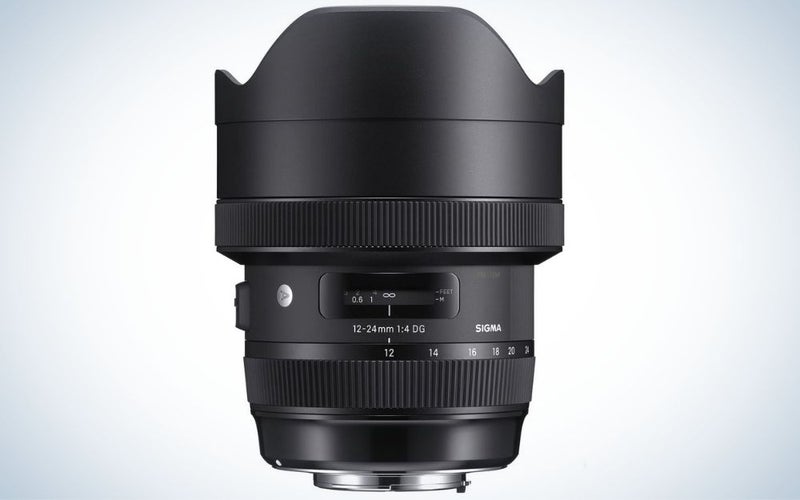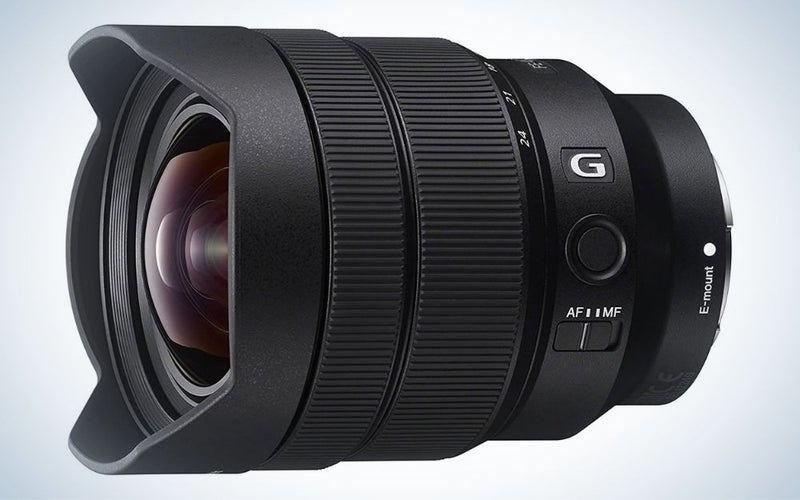
We may earn revenue from the products available on this page and participate in affiliate programs. Learn more ›
The best lenses for real estate photography will allow you to capture a room or exterior space in the best light to entice buyers. Photographs of real estate listings have always been important, but that is becoming even more true. It’s relatively common for people to purchase a home without ever seeing it in person. The listing photographs alone can give buyers confidence in their purchase or entice them to take a deeper look.
Successful real estate images should almost function as a walkthrough, showing the home’s layout and where key features are in relation to other areas of the house. The only way to show a property in such a way is to use a wide-angle lens. A wide-angle focal length will allow you to show nearly the entire room, even small ones like bathrooms.
- Best for Nikon cameras: AF-S NIKKOR 14–24mm f/2.8G ED
- Best for Canon cameras: Canon EF 11-24mm f/4L USM
- Best runner-up for Canon and Nikon: Sigma 12-24mm f/4 DG HSM Art
- Best for Sony cameras: Sony FE 12-24mm f/4 G
- Best for Fuji cameras: Fujifilm XF10-24mm F4 R OIS WR
- Best budget: Tokina Opera 16-28mm F/2.8 FX
How we chose the best lenses for real estate photography
The editors and writers at Popular Photography have decades of photography experience in just about every genre and have covered and reviewed just about every major camera on the market. When selecting the best lenses for real estate photography, we considered a handful of things. Focal length was the primary consideration, as real estate photography requires a lens wide enough to document large spaces. Distortion was also a significant factor. Although all ultra-wide-angles all have some distortion, we only selected lenses where it is straightforward (barrel or pincushion) and easy to correct in editing. Lastly, we looked at general quality related to sharpness, chromatic aberration, and vignetting.
The best lenses for real estate photography: Reviews & Recommendations
Best for Nikon cameras: AF-S NIKKOR 14–24mm f/2.8G ED
Nikon
Why it made the cut: The Nikkor 14-24mm is the best real estate lens option for Nikon DSLRs, with little distortion, excellent sharpness, and fantastic colors and contrast.
Key features
- Weight: 2.2 pounds
- Filter size: N/A
- Maximum aperture: f/2.8
- Lens mount: Nikon F
Pros
- Exceptional sharpness
- Minimal lens distortion
- Fast autofocus
- Wide maximum aperture for good low light performance
Cons
- Not compatible with standard filters
Though it is an older lens (released in 2007), the Nikkor 14-24mm is still one of the sharpest ultra-wide-angle lens options available. As a rectilinear lens, the distortion is minimal and easy to correct automatically in post. The distortion and chromatic aberration are also not much of an issue due to the optical design; it contains three aspherical elements and two extra-low dispersion elements. In addition, the lens has a Nano Crystal Coat to cut down on flare and ghosting, which is helpful when shooting towards windows with direct sunlight or with certain types of ceiling lights.
Nikon’s 14-24mm has a fixed maximum aperture of f/2.8, and it is impressively sharp even when wide open. Although that wide of an aperture doesn’t come into play much for real estate photography–you want to use a smaller aperture for that–it does make this lens a bit more versatile. The front element does protrude a decent amount, which means you cannot use traditional filters, and it is prone to hit things, but the built-in lens hood does help protect it.
Best for Canon cameras: Canon EF 11-24mm f/4L USM
Canon
Why it made the cut: Canon’s 11-24mm is the widest full frame lens on the market, and it also happens to be one of the sharpest ultra-wide angles as well.
Key features
- Weight: 2.6 pounds
- Filter size: Rear insert-type
- Maximum aperture: f/4
- Lens mount: Canon EF
Pros
- Exceptional sharpness
- Minimal distortion
- The widest focal length for full frame cameras
- Weather-sealed
Cons
- Expensive
- Heavy
The Canon EF 11-24mm f4L USM is an ultra-wide-angle designed for Canon full frame cameras. However, this lens would still be wide enough on a crop sensor for real estate photography due to the extremely wide focal length. It is a rectilinear lens, and the design of the 16 optical elements does a great job of reducing distortion and chromatic aberration. It also has excellent edge-to-edge sharpness, which is difficult to achieve on a lens with this wide of a focal length. This lens is touted to be the sharpest wide-angle lens available. And although the maximum aperture isn’t as wide as Nikon’s ultra-wide-angle offering, f/4 is still plenty for real estate work.
The lens body of the 11-24mm is sealed against dust and moisture, so you won’t have to fret if you get caught in bad weather while shooting a property’s exterior. It is a heavy lens, at 2.6 pounds, but real estate photography is usually done on a tripod, so the weight isn’t as much of a factor. The front element on this lens is also bulbous, though Canon has designed it to accept rear insert filters. If you don’t want something quite as wide, perhaps if you shoot higher-end architectural work, the Canon EF 16-35mm f/4L IS USM Lens is a great alternative.
Best runner-up for Canon and Nikon: Sigma 12-24mm f/4 DG HSM Art
Sigma
Why it made the cut: The Sigma 12-24mm lens is a sharp third-party option for Canon and Nikon that offers an ideal focal length range for real estate photographers.
Key features
- Weight: 2.5 pounds
- Filter size: N/A
- Maximum aperture: f/4
- Lens mount: Nikon F, Canon EF
Pros
- Reasonable price
- Good center sharpness
- Very minimal distortion, chromatic aberration, and vignetting
Cons
- Heavy
- Bulbous front element
For those who want the ultra-wide-angle option but may want to save a little bit, the Sigma Art 12-24mm is a great choice. It is the heaviest out of the three, but that shouldn’t be an issue for most real estate shoots. The maximum aperture isn’t excessively fast at f/4, but that’s more than wide enough in most real estate applications.
Sigma’s 12-24mm has excellent center sharpness. It does have softer corners when wide open (a common thing for wide-angles), but when stopped down to f/8 or so, that issue decreases significantly. Sigma’s lens beats out Canon’s in terms of chromatic aberration and vignetting, which is excellent considering the price is slightly lower. There is some visible distortion when zoomed out, but that practically goes away by 16mm. And what distortion there is, is easy to correct, which is a big benefit for those taking interior images. Lastly, for Sony users, there is an f/2.8 version that is also impressive.
Best for Sony cameras: Sony FE 12-24mm f/4 G
Sony
Why it made the cut: Sony’s 12-24mm f/4 is the lightest, most compact option on the list–weighing in at only 1.24 pounds–ideal for those who may frequently travel for their real estate shoots.
Key features
- Weight: 1.24 lb
- Filter size: N/A
- Maximum aperture: f/4
- Lens mount: Sony E
Pros
- Lightweight and compact
- Fast, quiet focus
- Good edge-to-edge sharpness
Cons
- Not compatible with standard filters
Sony’s 12-24mm f/4 G was their widest zoom offering for full frame cameras when released in 2017. While the new 12-24mm f/2.8 G Master released in 2023 has the same focal length range, you gain a stop in aperture. That comes at a price, though. The f/2.8 version is nearly double in price, which is why the f/4 made our list instead. For real estate needs, f/4 is plenty wide.
The center sharpness of the 12-24m f/4 is excellent, and while there is some falloff on the corners, it is minimal. There is slight barrel distortion at 12mm and pincushion distortion from 16-24, though it is easy to correct across the board. Sony’s Nano AR Coating helps to reduce flare and ghosting and does an excellent job of it, no less.
Best for Fuji cameras: Fujifilm XF10-24mm F4 R OIS WR
Fujifilm
Why it made the cut: This compact lens packs a lot of imaging power into a relatively small package.
Key features
- Weight: 13.6 oz
- Filter size: 72mm
- Maximum aperture: f/4
- Lens mount: FUJIFILM X
Pros
- Lightweight
- Affordable
- Robust weatherproofing
- Autofocus is excellent for both stills and video
Cons
- No hard stops on the focus ring
The Fujifilm XF10-24mm is one of two ultra-wide-angle zoom lenses available from Fuji. Fuji also offers the XF 8-16mm f/2.8 R LM WR if you need something slightly wider or with a stop more aperture, though it is twice the price. We picked the 10-24mm for this list since it is plenty wide for most real estate needs and is much more budget-friendly.
The XF10-24mm uses advanced optics such as four extra-low dispersion and four aspherical elements to reduce chromatic aberration and distortion and improve sharpness and color accuracy. In addition, Fuji uses a Super Electron Beam Coating (EBC), a multi-layered anti-reflective coating to cut down on lens flare and ghosting, a necessity for real estate lenses. This lens also has a filter thread, making it easier to use filters than other ultra-wide-angle options. This lens is also the lightest one on the list, at only 13.6 oz, so if you travel for your real estate gigs or partake in landscape photography, this is a great choice.
Best budget: Tokina Opera 16-28mm F/2.8 FX
Tokina
Why it made the cut: Tokina’s ultra-wide-angle hits all the critical parts of a real estate lens with minimal distortion, good focal length range, and excellent sharpness and still comes in significantly cheaper than its competitors.
Key features
- Weight: 2.09 pounds
- Filter size: N/A
- Maximum aperture: f/2.8
- Lens mount: Canon EF, Nikon F
Pros
- Minimal distortion and chromatic aberration
- Excellent sharpness
- Budget-friendly
Cons
- Heavy
- Bulbous front element
Despite being the older version of Tokina’s ultra-wide lens (they have a newer 17-35mm f/4 AT-X Pro FX), and being more expensive than the more recent version, the 16-28mm is the superior lens in most respects. First, you get 1mm more on the wide end, which, although it is a slight difference, helps with real estate photography. The 16-28mm also has better design and lens elements than the 17-35mm, resulting in better quality images. Images from this lens are sharp and clear, and autofocusing is accurate and reliable. In fact, the 16-28mm is said to be one of the sharpest third-party zoom lenses available.
Tokina’s 16-28mm is a large, heavy lens, though it still weighs less than the Nikon listed above. As with all ultra-wide-angle lenses, there is visible barrel distortion, but it is very simple to correct in editing. In addition, there is very minimal chromatic aberration and slight vignetting, but considering the price and focal length, it is impressive how little those things are an issue. And although the fast f/2.8 aperture isn’t a significant asset in real estate photography, it does make it more versatile and is one of the best low light lenses on the wide-angle spectrum.
Things to consider before buying the best lenses for real estate photography
The most crucial feature of a lens for real estate photography is a wide-angle focal length. You will want something wide enough to show most of a room, though not so wide that distortion becomes an issue. A fisheye lens is absolutely to be avoided, as the distortion is not correctable and will not give potential buyers a good sense of the home. Instead, a lens with a maximum focal length of between 12 and 16mm will cover a wide enough range without excessive distortion.
It is also worth pointing out that there is a bit of a difference between real estate photography and architectural photography. A less wide lens–something around 24mm–is better suited for higher-end architectural photography, as even the distortion from 12-16mm is seen as too much. Beyond focal length, there are a few other things to pay attention to before making your purchase.
Crop factor
Crop factor comes into play because it could impact the focal range that you get from a lens. If you have an APS-C–or crop sensor– camera, you will not get the full field of view you’d expect on a full-frame camera. For example, on a Canon APS-C such as the 90D, the crop factor is 1.6x. As a result, a 16-35mm lens on your D500 will be the equivalent of 25.6-56mm. The image will appear more zoomed-in than it would with those focal lengths on a full-frame camera. Unfortunately, 25mm is not wide enough for most real estate needs, so you will need a more extreme wide-angle if you have a crop sensor camera.
If you have a full-frame camera, you simply need to ensure that the lens you are looking at is compatible with full-frame cameras.
Zoom or prime lens
The second thing to consider is if you would like a zoom or prime lens. Prime lenses will have one fixed focal length, whereas zoom lenses provide a range of focal lengths. Generally speaking, prime lenses will be cheaper than zoom lenses, and they can also be sharper. However, prime lenses don’t have as much versatility as zooms since you are stuck with one focal length.
If sharpness is your primary goal, and you are okay using your feet as your zoom or packing a few different lenses for a shoot, then a prime lens or two will likely be a good fit. However, if you don’t want to be switching lenses and want more flexibility, a zoom option will be best.
Chromatic aberration and distortion
The last piece to look at when deciding on a lens is quality, part of which will be visible in the amount of chromatic aberration and distortion. While all wide-angle lenses will have some distortion (called barrel distortion in wide-angles) and chromatic aberration, they should be easily correctable in a quality lens. Some cameras will even correct distortion in-camera, or built-in lens profiles in programs like Adobe Photoshop can make adjusting for it a breeze.
Cheaper lenses will have more pronounced, exaggerated distortion and could even have a more complex form of distortion called mustache distortion. Mustache distortion has both pincushion and barrel distortion in one image, and it is extremely difficult to correct. In some cases, it may not be fixable without specialized software. In addition, heavy chromatic aberration in cheaper lenses may also not be fully correctable. So for quality, professional-level real estate images, stay away from excessively cheap lenses or lens brands that aren’t very common.
FAQs
Q: What type of lens is used for real estate photography?
Wide-angle and ultra-wide-angle lenses are the lenses of choice for real estate photography. Since listing images are used to show people a property, and viewers usually have limited attention spans, showing a full view of a room in just a few photos is best. Wide-angle lenses also allow potential buyers to see the layout of a home better, which helps them get a better feel for the space.
It is worth noting that you can get too wide of a lens for real estate photography. Fisheye lenses should not be used, as the distortion will not show a property accurately.
Q: How much does a lens for real estate photography cost?
Pricing for real estate lenses varies depending on the focal length and quality of the lens. However, they generally run between $500 on the low end and can get as high as $3,000 on the high end.
Q: What filter do real estate photographers use?
One of the most useful filters for real estate photographers is a circular polarizer. A circular polarizer will help cut down on glare and bring down highlights on areas like shiny floors or countertops, allowing the surfaces to show better in the photos.
Q: Can I shoot real estate with a 24mm lens?
A 24mm lens will work for certain types of properties and real estate photography needs. For example, higher-end architectural work actually calls for something like 24mm more so than something wider, as it will have less distortion and be more accurately convey the space and features. However, for small houses or more basic real estate photography and vacation rental photographs, a 24mm lens will not be wide enough. It will likely result in choppy images of the listing that do not show it well.
Final thoughts on the best lenses for real estate photography
The best lenses for real estate photography will largely depend on what camera system you use. That said, Canon’s 11-24mm is the sharpest wide-angle lens available overall. So that may be your best bet if you are starting from scratch or willing to switch systems. All other major camera systems have quality wide-angle lenses as well, however. The options listed above will serve you well for real estate photography specifically and any other wide-angle uses.
The post The best lenses for real estate photography in 2023 appeared first on Popular Photography.
Articles may contain affiliate links which enable us to share in the revenue of any purchases made.








